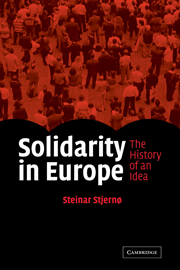Book contents
- Frontmatter
- Contents
- List of tables
- Acknowledgements
- List of abbreviations
- Introduction: to study the idea of solidarity
- Part I Three traditions of solidarity
- 1 Solidarity in classic social theory
- 2 Politics: solidarity from Marx to Bernstein
- 3 Religion: solidarity in Catholicism and Protestantism
- Part II The idea of solidarity in politics in Western Europe
- Part III The present precariousness of solidarity
- References
- Index
3 - Religion: solidarity in Catholicism and Protestantism
Published online by Cambridge University Press: 29 March 2010
- Frontmatter
- Contents
- List of tables
- Acknowledgements
- List of abbreviations
- Introduction: to study the idea of solidarity
- Part I Three traditions of solidarity
- 1 Solidarity in classic social theory
- 2 Politics: solidarity from Marx to Bernstein
- 3 Religion: solidarity in Catholicism and Protestantism
- Part II The idea of solidarity in politics in Western Europe
- Part III The present precariousness of solidarity
- References
- Index
Summary
Religions and churches had organised the belief system in society long before liberalism and socialism developed as coherent ideologies. Religion created a common language and a frame of reference for communication between believers. It created meaning, purpose and a sense of community, and established rules of behaviour for believers that regulated their relationship to one another and to those who did not believe or who believed in another religion. It developed norms and rules about the relationship between the individual, the family, civil society and the state. Durkheim saw religion as the social cement of society, and social scientists have argued that it was the sharing of religious rituals that created the solidarity found in societies of old (Turner and Rojek 2001). Thus, religion was a bond between people long before ideas of nationhood or class existed. When the idea of class solidarity was developed, the development was in conflict with established loyalties to religion.
The Roman Catholic Church developed hegemony and was for many centuries the only powerful religion in Western Europe. In the sixteenth century the Reformation brought about a split dividing western Europe into a predominantly Catholic south and a predominately Protestant north. There were zones of mixed religions, most notably from Ireland to the Alps. When the political parties of the labour movement were established in the latter half of the nineteenth century, their socialist ideology brought them into conflict not only with bourgeois and petty bourgeois political opponents, but also with Christians and their churches.
- Type
- Chapter
- Information
- Solidarity in EuropeThe History of an Idea, pp. 60 - 90Publisher: Cambridge University PressPrint publication year: 2005
- 1
- Cited by

